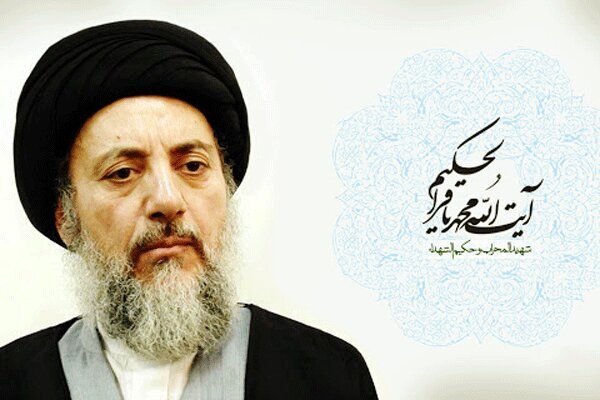Ayatollah Mohammad Bagher Hakim; From the establishment of the Islamic Supreme Council to martyrdom

Mehr News Agency-International Group: Martyr Ayatollah Mohammad Baqer Hakim is one of the most important contemporary influential figures in Iraq. Coming from a well-known and influential family in the Iraqi society, gave him a valuable place in the developments of the Shia society and especially the organization of the Shia political groups during the Baath Party rule. During the initial period of Saddam’s fall, he also played a central role in confronting the policies of the invaders and mobilizing the Shiites to regain their real position in the politics and power of Iraq. On the occasion of the martyrdom anniversary of this great scholar, we will have a look at his life, struggles and martyrdom.
Politics against the Baath regime
Syed Mohammad Baqer Hakim, the son of Shia authority, Ayatollah Seyyed Mohsen Hakim was born in 1317 in Najaf city. He went to the seminary since childhood and succeeded in receiving a degree in jurisprudence, principles and Quranic sciences in the scientific field. During his studies, he benefited from the existence of the famous professors such as Ayatollah Seyedaboul Qasem Khoei, Ayatollah Seyed Mohsen Hakim, Allameh Shahid Seyed Mohammad Baqer Sadr and Ayatollah Sheikh Morteza Al Yassin. Various works have been left from him in the political and cultural fields, centered on the Qur’an and the biography of the Ahl al-Bayt (PBUH).
Ayatollah Hakim, as a famous scholar besides his religious activities, always paid special attention to politics and joined political fighters in his early youth. Among Iraqi Shiites, he was one of the pioneers of political activity as well as fighting against the Baathist regime, and in this way, he was imprisoned for many years in the prisons of the Baathist regime. He was arrested for the first time in 1974 along with Shahid Mohammad Bagher Sadr and was persecuted and tortured after being transferred to Baghdad. He was arrested again in 1976 and was finally released with the efforts of Imam Musa Sadr. In 1977, he was arrested again and sentenced to life imprisonment. However, in 1979, after the issuance of a general amnesty order, they were released along with a number of other prisoners.
Ayatollah Hakim came to Tehran after the victory of the Islamic Revolution of Iran and a few months before the start of Iraq’s military aggression against Iran and settled near Beit Imam. In a speech in the presence of the Imam (RA), Hakim announced his readiness to confront the Ba’athist government. Imam (RA) also told them that “the path you have chosen is difficult and difficult. You are the son of the great Shia authority Ayatollah Seyed Mohsen Hakim; You can go to Qom and continue your seminary studies or you can continue to fight; You are free to choose one of these two ways.” Hakim chose the second way and fighting against the Baathist government.
Establishment of the Islamic Supreme Council of Iraq
The Supreme Council of the Islamic Revolution of Iraq is one of the moderate Shiite Islamist currents in Iraq, which was formed on November 17, 1982. The purpose of forming this group was to concentrate Iraqi jihadist forces with the cooperation of Hizb al-Dawa members against the Baath regime. Since the beginning of its activity, the Supreme Council has opened many offices in different parts of the world and has had many activities. This group was an opponent of Saddam’s regime and its leaders, including Mohammad Baqer Hakim, Abdul Aziz Hakim and Ammar Hakim, played the main roles in the Iraqi political process after the US invasion of Iraq in 2003. Majlis Ala has a wide social base among Iraqi Shiites and has a close relationship with the Shia authority, especially Ayatollah Sistani. Political observers knew this parliament as a self-proclaimed government during the Saddam period.
The Supreme Council, as a comprehensive framework for all Iraqi Islamic opposition forces, initially included all independent Islamic opposition parties and individuals based in Iran. It even included some opposition Sunni leaders and nationalists in the first period. The membership of individuals in this parliament was not based on group affiliation, but on acceptance, history of struggle and ability of individuals in a natural and non-bureaucratic process in the first period. Ayatollah Hakim announced the official formation of this assembly in Tehran and had a significant connection with Iran. At the same time, this group created and operated active branches in Iran, Syria and England. The first conference of the Supreme Assembly was held in Tehran in 1985 under the title “Conference for the Iraqi People”. Non-Islamic opposition groups also participated in that conference.
Formation of the Badr Military Organization
The warm relations of the Supreme Majlis with Iran became more obvious in the imposed war and the actions of this group against Saddam. Ayatollah Hakim in the Supreme Assembly of the Islamic Revolution of Iraq on the 9th of Rajab in 1984 established a powerful military arm called the 9th Badr Division. This army included 12 thousand Iraqi mujahids present in Iran. A group of Badr forces were stationed in the Ahwar region between Basra, Maysan and Dhi Qar, especially around Horul Howayza, and during the war, they played a role in identifying the area and providing grounds for the Khyber, Badr operations, the series of Quds operations, and the 4th Ashura operation in the north of Horul Howayza. they did The Badr division also played a role in important operations such as Karbala 2, Karbala 5, and Wal-Fajr 10, and after the war, the experiences of this division were provided to the revolutionary forces of the 1991 Shabaniyah intifada, which played a very important role in creating a challenge for the Baathist government.
Fighting the occupying forces
Ayatollah Hakim played an important role in the rehabilitation of Shia rituals in Iraq after the fall of Saddam Hussein. In addition, from a political point of view, his approach was to confront extremist groups and occupying forces. The Supreme Council, which was active as an opposition group during the Saddam period, maintained the same role after the fall of Saddam. This issue was particularly highlighted by the presence of the representatives of the Supreme Parliament of the Islamic Revolution of Iraq in the conferences held in London and Salah al-Din. In the short time that they were in the post-Saddam Iraqi political environment after returning to the country, they reacted to the actions of the United States, including the arrests of the leaders of the military branch of the Supreme Assembly of the Islamic Revolution of Iraq.
Martyrdom of Ayatollah
After the fall of Saddam and the spread of takfiri groups that were present in Iraq in the name of confronting the crusaders, widespread instability prevailed in Iraq. But in fact, the main goal of these groups was to disrupt the political process in Iraq and, as a result, weaken the national government with the Shiite majority. In this way, the assassination of Shiite and great Iraqi figures who could play a major role in the new Iraq was put on the agenda. Ayatollah Hakim was also one of these influential figures and in fact the main symbol of the struggle clergy in Iraq. On this basis, while few months had passed since his arrival in Iraq, he was martyred in a terrorist operation on the 7th of Shahrivar 2003 (August 29, 2003) after performing Friday prayers in Najaf. The day of his martyrdom in Iraq is named Martyr’s Day.
After the martyrdom of Ayatollah Hakim, the Supreme Leader of the Islamic Revolution, in a message in this connection, they mentioned him with this sentence: Iraq fought against the evil regime of Saddam and after the fall of that statue of evil and corruption, it stood as a strong barrier against the American and British invaders and started a difficult struggle against their evil plans and offered itself as a martyr in the way of this great jihad and joining He had prepared many martyrs of the family of Moazzam Al-Hakim and other martyrs of knowledge and virtue in Iraq. He also said that: “The martyred Ayatollah Hakim was the embodiment of the demands of a nation that sees its religion, independence and the future of its country under threat and its home under the boot of the invaders and wants to defend its religious and national identity against the aggressors. slow The martyrdom of this honorable Sayyid is a fatal tragedy for the Iraqi nation and another proof of the crime of the invaders who have imposed insecurity and chaos on Iraq with their illegal presence. But the enemies of independent and Muslim Iraq should know that with this oppressed martyrdom, the determination and resistance of the Iraqi nation against the plans and goals of arrogance and Zionism and their faith and loyalty to the line of Islam and religious leadership will not weaken and will become more stable, contrary to their wishes. God willing”
Result
Ayatollah Seyyed Mohammad Baqer Hakim, one of the children of Seyyed Mohsen Hakim, a reference point for Shiite imitation, and one of the important influential figures in Iraq during the Baathist regime and then at the beginning of the occupation of Iraq by the Iraqi forces He was American. During Saddam’s rule, he played an important role in forming resistance groups against Saddam’s government, especially in the Iraq-imposed war against Iran and the Iraqi intifada. In the period after Saddam, he played an important role in the revival of Shia rituals. He can be considered as one of the most important factors behind the mobilization of Shiites and their reaching a real position in the political atmosphere of Iraq.
Sajad Moradi Kalardeh, researcher of international relations


